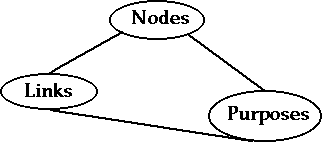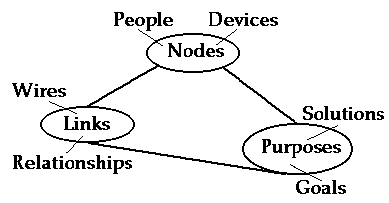A Network Model:
How to See Both People and
Technology Networks
By
Jessica Lipnack and Jeffrey Stamps
The Seybold Series #4 - September, 1989
Market research shows that CEO's today are struggling with human
resource issues, not technology issues. The biggest customers of
major hardware vendors, those most computerized and networked, are
demanding answers to business and organizational questions raised
by the technology.
"How do I work in the new distributed environment? "How
do I manage in it?" "How can the company as a whole become
more distributed, flexible, and responsive?" New questions
at all levels of the organization.
Networking promises to overcome age-old barriers to cooperative
work, the shear impact of physical distance on natural communication
and collaboration. But "networking," the verb, the action,
the "doing something," does not automatically come with
"networks," the noun. Just installing technology is not
enough. It's how people use it that counts.
People (net)working together all too often fails to occur on the
networks. Companies fail to benefit from the potential of a computer-based
communications glue that ties the enterprise together. Yet the emerging
success stories of incredibly successful distributed work indicate
that new ways of working are possible.
Networks and networking can bridge the gap between organizations
and technology. By viewing organizations as networks, alongside
our conventional views of them as hierarchies and bureaucracies,
we have a natural language for mapping onto technology configurations.
Or, more importantly, a way of understanding human organization
so that technology can be configured to support people.
A Network Definition
For a decade the Networking Institute, Inc. has been studying people
networks, from volunteer groups and social movements to distributed
businesses and high-tech teams. People networks, we have learned,
have the same structure as technology networks
In 1985, as the networking boom was just beginning, Digital Equipment
Corporation put out a marketing booklet called Networking: The
Competitive Edge, and defined a network this way:
A network comprises two or more intelligent devices (computer systems,
intelligent terminals, and intelligent peripherals) linked in order
to exchange information and share resources.
Leaving out the now dated parenthetical specifics, DEC's definition
shows three essential elements of a network: nodes, links,
and purpose. Networks are nodes linked together.in order
to do something, to achieve a purpose.

Nodes are the things, the centers of activity. Links are the relationships,
the connections between nodes. Purpose, the "in order to,"
is the critical ingrediant in bringing nodes and links alive as
a coherent unity.
Technology Networks
In technology networks, wire, cable, microwave and other links,
together with the supporting hardware, constitute the traditionally
narrow view of "the network." But wires by themselves
are nothing; the network as a whole includes the devices, the boxes
from mainframes to PCs, that are connected. And, critically, it
includes the applications run on the network, the work processes
that embody the "in order to" that is the raison d'etre
of the network.
While vendors might be selling wires, boxes, and software separately,
their customers are trying to run the result as an integrated whole.
When a user sits down and logs on, it is how the network works as
a whole that matters.
Organizational Networks
In organization networks, people and groups are the nodes. People
individually are linked in networks, both in small groups and in
large-scale associations. And, organizational networks may span
multiple levels, where small groups are linked together into a larger
project or businesses join associations of their peers.
Relationships are the links between people and groups. Organizational
networks are perceived in terms of patterns of interaction that
support human relationships. While it is notoriously difficult to
"see" or quanitify relationships, interaction can be observed.
Interaction, in turn, depends upon communication, which is very
physical and very concrete.
Organizational purpose is expressed through goals. It is a clear
and shared purpose that is the motivational glue that holds an organizational
network together. Without purpose, a people network will fail to
jell. Without renewed and sustained goals, a human network will
disintegrate.
Only people who think for themselves can internalize goals and
act to benefit a larger shared purpose without coercion or detailed
policies. The decision-making and competence required of people
working successfully in a network echos the "intelligence"
required of networked technology devices. In both people and technology
networks, the nodes have an independence and autonomy of action
separate from their cooperation as part of a successful network.

A Common Language
Nodes, links, and purpose--these concepts provide a common language
for understanding organizations and information technology. Nodes
are people and devices. Links are relationships and wires. Purposes
are goals and applications.
For a technology company, network language provides a way to leverage
technical knowledge to bridge the gap to organizational understanding.
For their customers, and for themselves as companies of people,
network language provides a new way to look at the organization,
one that supplements traditional hierarchical and bureaucratic views.
Seeing an organization as distributed work processes and networks
of people provides a natural configuration template for technology
networks, and a challenge to the need for fundamental technology
flexibility in adapting to changing people patterns.
The network is a powerful conceptual model, a tool for thinking
about technology and people issues. At the top level the model can
be expressed with a handful of essential elements--nodes, links,
and purpose. This provides a mental model for grasping the distributed
complexities of organizations of all sizes, just as a tree diagram
serves as a mental model for authority structures of all sizes.
Networks can be the size of nations in international federations,
and are a natural model for multinational corporations, industry
associations, distributed work teams, Old Boys, and friends.
General Networks
Networks, like systems, have an abstract general structure.
That is, the conceptual framework applies to more than one domain
of knowledge, in this case organizations and technology. The value
of general models is the role they play in integrating knowledge
from conceptually different worlds, bridging gaps.
While the concept of "system" has flourished in the technology
arena, in the social world it has developed primarily in its "closed"
form with a rigid structure. Organizationally, "The System"
carries connotations of an "opaque" massive structure
that ensnarls and oppresses individuals. In a system, the parts
tend to get lost in the whole. It's the whole that's important.
A network is a naturally transparent and open system. Its parts,
the nodes, the objects, are clearly differentiated and have an internal
integrity. Relationships are a fully visible and acknowledged part
of tying the nodes together as a whole. And through its multiple
communications loops, a network has natural feedback characteristics
and cybernetic goal-seeking abilities, purposefulness even at the
level of thermostat in a house.
When the network model is used to describe associations of people,
it is the centers of activity and the communications patterns that
predominate. This is not to say that authority structures and policy
patterns are not important, only that the network viewpoint provides
additional value and another way to grasp the complexities of human
beings working together.
Flexible networks address core human resource issues. Networks
provide a way of designing and managing distributed work, finding
and using people and skills where they are and when they are needed,
load-balancing and reducing relocation stress. Successful networks
tap into the primal source of motivation, individual values and
participation.
The network idea has been around for centuries. Now, it is finding
new application as a strategy for seeing the future at work today.
As our only-decades-old transition from industrialism to the Information
Age continues to accelerate, networks will become increasingly important.
|